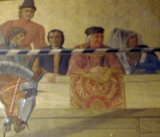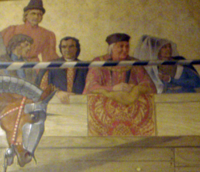
Charles Trick Currelly
Encyclopedia
Charles Trick Currelly (January 11, 1876 – April 17, 1957) was a Canadian
clergy
man and archeologist
, and the first director of the Royal Ontario Museum
from 1914 to 1946.
 Currelly was born in Exeter, Ontario
Currelly was born in Exeter, Ontario
. He attended private school
s and later Harbord Collegiate Institute
and the University of Toronto
. Currelly entered the ministry in 1899 but went to London
in 1902 and was appointed to the staff of the Egyptian Exploration Fund. In 1903 he joined the British School of Archaeology in Athens
. In 1902-1903 he discovered the tomb of the pharaoh
Admes and also a stone which revealed the parentage of the founders of the Eighteenth Dynasty
. In 1903-1904 he was in charge of the explorations along the Fayoum
and in the northern marsh
es in Egypt. In 1904-1905 he led an exploring party in Sinai
, and afterward engaged in excavations in Crete
, Asia Minor
, and Syria
. He discovered the statue of Hathor
; also the inscription and portrait of Khufu
, for which the Khedive of Egypt
conferred on him the Order of the Majidieh. Later he was elected a fellow of the Royal Geographical Society
. In 1907 he was appointed curator
of the Museum of Archaeology at the University of Toronto. After eight years of explorations and collecting in Egypt and Europe, he returned to Canada in 1919. He published Sinai, an account of his explorations.
Canada
Canada is a North American country consisting of ten provinces and three territories. Located in the northern part of the continent, it extends from the Atlantic Ocean in the east to the Pacific Ocean in the west, and northward into the Arctic Ocean...
clergy
Clergy
Clergy is the generic term used to describe the formal religious leadership within a given religion. A clergyman, churchman or cleric is a member of the clergy, especially one who is a priest, preacher, pastor, or other religious professional....
man and archeologist
Archaeology
Archaeology, or archeology , is the study of human society, primarily through the recovery and analysis of the material culture and environmental data that they have left behind, which includes artifacts, architecture, biofacts and cultural landscapes...
, and the first director of the Royal Ontario Museum
Royal Ontario Museum
The Royal Ontario Museum is a museum of world culture and natural history in Toronto, Ontario, Canada. With its main entrance facing Bloor Street in Downtown Toronto, the museum is situated north of Queen's Park and east of Philosopher's Walk in the University of Toronto...
from 1914 to 1946.

Exeter, Ontario
Exeter is a Canadian community in the municipality of South Huron, in the southern portion of Huron County, Ontario, located approximately 50 kilometres north of London. The community proclaims itself the "Home of the White Squirrel", owing to the presence of the unusually-coloured mammals...
. He attended private school
Private school
Private schools, also known as independent schools or nonstate schools, are not administered by local, state or national governments; thus, they retain the right to select their students and are funded in whole or in part by charging their students' tuition, rather than relying on mandatory...
s and later Harbord Collegiate Institute
Harbord Collegiate Institute
Harbord Collegiate Institute is a public secondary school located in downtown Toronto, Canada. Specifically, the school is located in the Palmerston-Little Italy/The Annex neighbourhood, situated on the north side of Harbord Street, between Euclid Ave. and Manning St...
and the University of Toronto
University of Toronto
The University of Toronto is a public research university in Toronto, Ontario, Canada, situated on the grounds that surround Queen's Park. It was founded by royal charter in 1827 as King's College, the first institution of higher learning in Upper Canada...
. Currelly entered the ministry in 1899 but went to London
London
London is the capital city of :England and the :United Kingdom, the largest metropolitan area in the United Kingdom, and the largest urban zone in the European Union by most measures. Located on the River Thames, London has been a major settlement for two millennia, its history going back to its...
in 1902 and was appointed to the staff of the Egyptian Exploration Fund. In 1903 he joined the British School of Archaeology in Athens
Athens
Athens , is the capital and largest city of Greece. Athens dominates the Attica region and is one of the world's oldest cities, as its recorded history spans around 3,400 years. Classical Athens was a powerful city-state...
. In 1902-1903 he discovered the tomb of the pharaoh
Pharaoh
Pharaoh is a title used in many modern discussions of the ancient Egyptian rulers of all periods. The title originates in the term "pr-aa" which means "great house" and describes the royal palace...
Admes and also a stone which revealed the parentage of the founders of the Eighteenth Dynasty
Eighteenth dynasty of Egypt
The eighteenth dynasty of ancient Egypt is perhaps the best known of all the dynasties of ancient Egypt...
. In 1903-1904 he was in charge of the explorations along the Fayoum
Al Fayyum Governorate
Faiyum Governorate is one of the governorates of Egypt in the middle of the country. Its capital is the city of Faiyum, located about 81 mi south west of Cairo...
and in the northern marsh
Marsh
In geography, a marsh, or morass, is a type of wetland that is subject to frequent or continuous flood. Typically the water is shallow and features grasses, rushes, reeds, typhas, sedges, other herbaceous plants, and moss....
es in Egypt. In 1904-1905 he led an exploring party in Sinai
Sinai Peninsula
The Sinai Peninsula or Sinai is a triangular peninsula in Egypt about in area. It is situated between the Mediterranean Sea to the north, and the Red Sea to the south, and is the only part of Egyptian territory located in Asia as opposed to Africa, effectively serving as a land bridge between two...
, and afterward engaged in excavations in Crete
Crete
Crete is the largest and most populous of the Greek islands, the fifth largest island in the Mediterranean Sea, and one of the thirteen administrative regions of Greece. It forms a significant part of the economy and cultural heritage of Greece while retaining its own local cultural traits...
, Asia Minor
Anatolia
Anatolia is a geographic and historical term denoting the westernmost protrusion of Asia, comprising the majority of the Republic of Turkey...
, and Syria
Syria
Syria , officially the Syrian Arab Republic , is a country in Western Asia, bordering Lebanon and the Mediterranean Sea to the West, Turkey to the north, Iraq to the east, Jordan to the south, and Israel to the southwest....
. He discovered the statue of Hathor
Hathor
Hathor , is an Ancient Egyptian goddess who personified the principles of love, beauty, music, motherhood and joy. She was one of the most important and popular deities throughout the history of Ancient Egypt...
; also the inscription and portrait of Khufu
Khufu
Khufu , also known as Cheops or, in Manetho, Suphis , was a Pharaoh of Ancient Egypt's Old Kingdom. He reigned from around 2589 to 2566 BC. Khufu was the second pharaoh of the Fourth Dynasty. He is generally accepted as being the builder of the Great Pyramid of Giza, one of the Seven Wonders of...
, for which the Khedive of Egypt
Khedive
The term Khedive is a title largely equivalent to the English word viceroy. It was first used, without official recognition, by Muhammad Ali Pasha , the Wāli of Egypt and Sudan, and vassal of the Ottoman Empire...
conferred on him the Order of the Majidieh. Later he was elected a fellow of the Royal Geographical Society
Royal Geographical Society
The Royal Geographical Society is a British learned society founded in 1830 for the advancement of geographical sciences...
. In 1907 he was appointed curator
Curator
A curator is a manager or overseer. Traditionally, a curator or keeper of a cultural heritage institution is a content specialist responsible for an institution's collections and involved with the interpretation of heritage material...
of the Museum of Archaeology at the University of Toronto. After eight years of explorations and collecting in Egypt and Europe, he returned to Canada in 1919. He published Sinai, an account of his explorations.
See also
- Beardmore RelicsBeardmore RelicsThe Beardmore Relics are a cache of Viking Age artifacts, said to have been unearthed near Beardmore, Ontario, Canada, in the 1930s. The cache consists of a Viking Age sword, an axe head, and a bar of undetermined use . It has been claimed by some that the relics are proof of the early Norse...
, a supposed archaeological find, claimed by Currelly to be evidence of the ancient Norse in Ontario; today it is considered a hoax.

